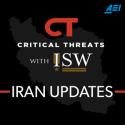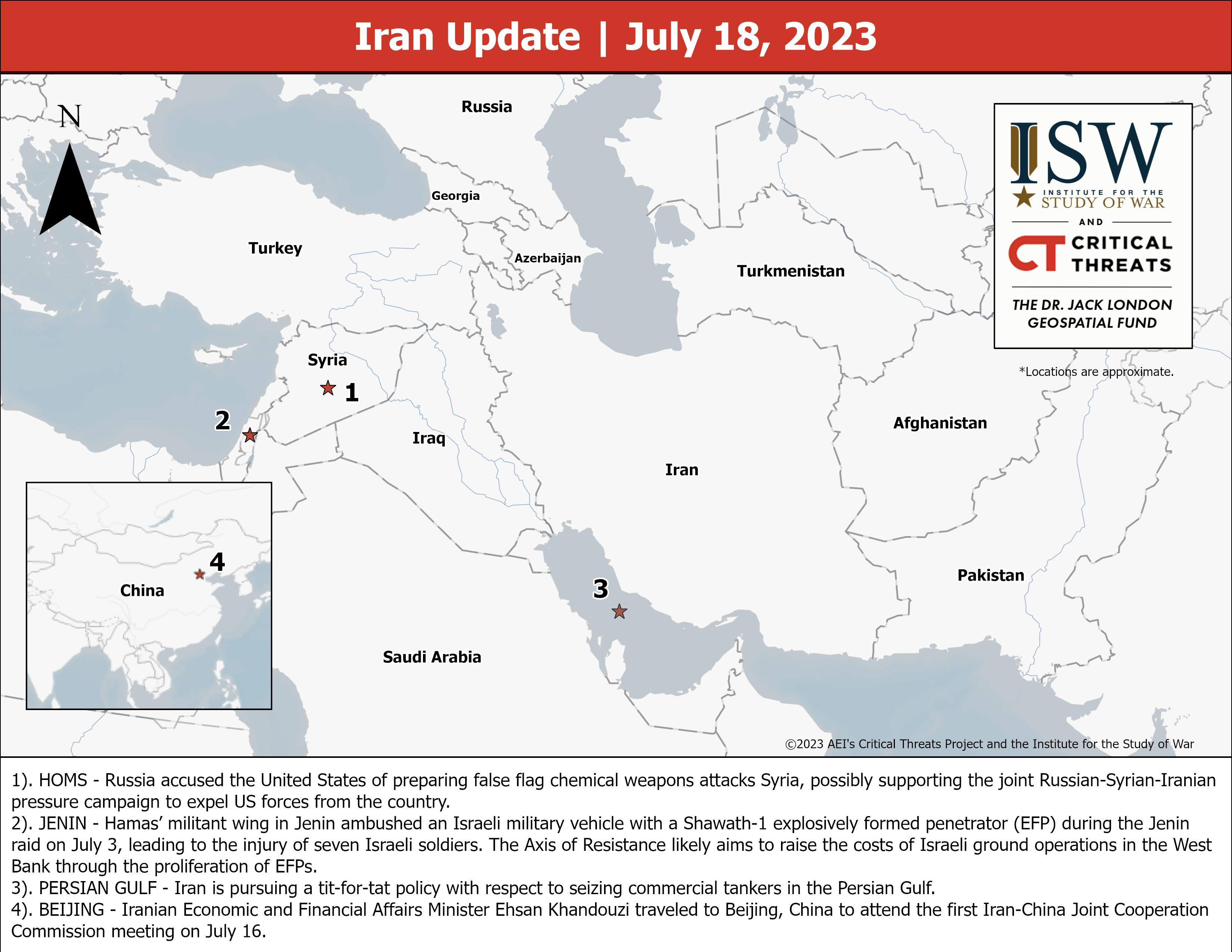 |
 |
Iran Update, July 18, 2023

Iran Update, July 18, 2023
Ashka Jhaveri, Andie Parry, Annika Ganzeveld, Amin Soltani and Kitaneh Fitzpatrick
The Iran Update aims to inform national security policy by providing timely, relevant, and independent open-source analysis of developments pertaining to Iran and its Axis of Resistance. This update covers political, military, and economic events and trends that affect the stability and decision-making of the Iranian regime. It also provides insights into Iranian and Iranian-sponsored activities abroad that undermine regional stability and threaten US forces and interests. The Critical Threats Project (CTP) at the American Enterprise Institute with support from the Institute for the Study of War (ISW) provides these updates Monday through Friday. To receive Iran Updates via email, please subscribe here.
The Institute for the Study of War (ISW) with support from the Critical Threats Project (CTP) at the American Enterprise Institute launched a new interactive map of Iran and the Middle East. The map depicts events in Iran that affect the stability of the Iranian regime, namely anti-regime protests and reported poisoning incidents. It also shows developments in Syria that jeopardize regional stability and pose threats to US forces and interests, including Iranian and Iranian-backed militia positions.
Key Takeaways
- Russia accused the United States of preparing false flag chemical weapons attacks against Syria, possibly supporting the joint Russian-Syrian-Iranian pressure campaign to expel US forces from the country.
- Hamas’ militant wing in Jenin ambushed an Israeli military vehicle with a Shawath-1 explosively formed penetrator (EFP) during the Jenin raid on July 3, leading to the injury of seven Israeli soldiers. The Axis of Resistance likely aims to raise the costs of Israeli ground operations in the West Bank through the proliferation of EFPs.
- Iran is pursuing a tit-for-tat policy with respect to seizing commercial tankers in the Persian Gulf.
- Iranian Economic and Financial Affairs Minister Ehsan Khandouzi traveled to Beijing, China to attend the first Iran-China Joint Cooperation Commission meeting on July 16.
Iranian Activities in the Levant
This section covers Iranian efforts to consolidate and expand Tehran’s economic, military, and political influence throughout the Levant especially in Syria. This section examines some of the many campaigns that Iran is pursuing to achieve this strategic objective. CTP will update and refine our assessments of these campaigns over time and in future updates.
Russia accused the United States of preparing false flag chemical weapons attacks against Syria, possibly supporting the joint Russian-Syrian-Iranian pressure campaign to expel US forces from the country. Russian Troops of Radiological, Chemical, and Biological Defense and the Syrian Arab Army specialists organized a military exercise in the desert between July 16-18 adjacent to the 55-kilometer deconfliction zone that surrounds the US Al Tanf garrison.[1] The exercise simulated a battle in which US-affiliated forces use chemical weapons. The soldiers learned how to operate the RPO-A Shmel, which is a man-portable, single-use, rocket-assisted thermobaric weapon, in a chemical environment.[2] Russia strategically places military exercises to influence adversaries.[3] US President Joe Biden said the United States eliminated its entire chemical weapons stockpile on July 7.[4] The military exercise followed Russian Foreign Intelligence Service (SVR) Director Sergey Naryshkin accusing the United States on July 3 of using false flag attacks to undermine Syrian normalization attempts with the Arab world.[5] The Russian Ministry of Defense accused the United States in 2018 of preparing false flag chemical attacks against civilians in Syria.[6] Naryshkin’s comments preceded rumored International Coalition attacks into regime-controlled territory triggering a surge beginning on July 7 of Iranian-backed, Russian-backed, and Syrian regime militants deploying to eastern Syria.
CTP has observed Iran preparing to resume its campaign to expel US forces from the Middle East since early June. Comments from a senior US defense official on July 14 about growing ties between Iran, Russia, and Syria across the Middle East are consistent with CTP’s observations.[7] The official noted Russian military activity has increased in frequency and aggression since March and stems from growing cooperation between Moscow, Tehran, and the Syrian government. Russian military aircrafts have repeatedly engaged US aircrafts over Syria in an unprofessional manner, violating deconfliction protocols. A Russian fighter jet flew close a manned US surveillance aircraft over Syria on July 17.[8] US Chairman of the Joint Chiefs of Staff General Mark Milley said there is no evidence that the Russian engagement with US aircrafts is linked to Ukraine, which suggests that the flights pertain to Russia’s objectives regarding Syria.[9] CTP will follow up in tomorrow’s update with an assessment about how Iran and Russia may be amplifying rumored International Coalition attacks as part of a campaign to expel US forces from Syria.
Hamas’ militant wing in Jenin ambushed an Israeli military vehicle with a Shawath-1 explosively formed penetrator (EFP) during the Jenin raid on July 3, leading to the injury of seven Israeli soldiers.[10] The attack was the first use of an EFP in the West Bank. The group announced on July 15 that it manufactured the EPFs in the West Bank.[11] Hamas has manufactured and used EPFs in Gaza since 2007.[12] Lebanese Hezbollah (LH) outlet Al Mayadeen stated that the Shawath-1 EPFs’ similarity to devices used by LH and Iraqi militants in the 2000s “indicates a possible growing collaboration between various parties in the axis of resistance.”[13] Al Mayadeen also framed the EFP production by Hamas in the West Bank as a major breakthrough in the engineering capabilities of Palestinian groups.[14] EPFs require specially manufactured concave copper disks, indicating Hamas militants either imported or received the specific instruction and capacity to produce the disks. Iran manufactured and facilitated distribution of the copper disks to Iraqi militants for use against US forces in Iraq.[15]
Israeli military officials framed the July 3 to 5 Jenin operation as a strategic and preventive measure to degrade Palestinian militant capabilities.[16] The IDF claimed the Jenin raid destroyed several Palestinian command-and-control centers, six explosives laboratories with more than 14 improvised explosive devices, and weapons caches with small arms and explosive materials.[17] Hamas’ militant wing in Jenin claimed it still possessed EFPs after the raid.
The Axis of Resistance likely aims to raise the costs of Israeli ground operations in the West Bank through the proliferation of EFPs. Israel’s reduced access to the West Bank would enable Iran to help rebuild degraded Palestinian militant groups and military capacities, as CTP previously assessed it intended to do.[18] Denying Israel access to Jenin and other militant hotbeds would strengthen Palestinian militants’ ability to target Israel in ground operations. These aims are consistent with comments from Islamic Revolutionary Guard Corps (IRGC) Commander Hossein Salami, who stated in August 2022 that the IRGC intends to increasingly focus on directing ground operations against Israel from the West Bank.[19]
Iranian Domestic and Political Affairs
This section covers factors and trends affecting regime decision-making and stability. CTP will cover domestic politics, significant protest activity, and related issues here.
Iran is pursuing a tit-for-tat policy with respect to seizing commercial tankers in the Persian Gulf. IRGC Navy Deputy Commander for Research and Development Rear Admiral Ahmad Rasti stated on July 18 that Iran has seized commercial tankers in response to Western seizures of Iranian tankers.[20] Rasti noted Iran seized British and Greek tankers in 2019 and 2022, respectively, because Britain and Greece had seized Iranian ships and cargo. The Wall Street Journal reported that recent Iranian seizures of commercial tankers in the Persian Gulf were in response to the US seizure of a Greek-owned tanker carrying Iranian oil in late April.[21] The report is consistent with previous Western media reporting.[22]
The United States deployed several F-16 and F-35 fighter jets and the guided-missile destroyer USS Thomas Hudner to the Persian Gulf between July 14 and 17 to deter further Iranian tanker seizures.[23] The Artesh Navy attempted to seize two commercial tankers in the Strait of Hormuz on July 5 and the IRGC Navy seized another in the Persian Gulf on July 6.[24] The US Department of Defense similarly announced on May 12 that it would bolster the Fifth Fleet’s defensive posture in the Persian Gulf after Iran seized three international vessels in the Strait of Hormuz between April 27 and May 12.[25]
Iranian Economic and Financial Affairs Minister Ehsan Khandouzi traveled to Beijing, China to attend the first Iran-China Joint Cooperation Commission meeting on July 16.[26] Representatives of Iran’s oil, agriculture, roads and urban development, foreign affairs, and industry, mines, and trade ministries accompanied Khandouzi.[27] Representatives of Iran’s Central Bank also attended the commission meeting. Khandouzi presented several “priority investment projects” covering energy, industry, mining, agriculture, and healthcare to Chinese officials. Khandouzi remarked that Chinese officials “promised” to eliminate unspecified “barriers” to Iranian trade with China. This statement suggests that Iran and China’s economic relationship in recent months has not been as harmonious as Iranian officials and media frequently portray.[28]
Iran seeks numerous economic benefits from China. The New York Times, citing a draft of the March 2021 Iran-China 25-Year Cooperation Agreement, previously reported that China agreed to invest 400 billion dollars in Iran over 25 years in exchange for Iranian oil.[29] China will invest in numerous fields, including banking, telecommunications, ports, railways, health care, and information technology. Iran has sought Chinese investment in numerous infrastructure projects, including, most recently, in a Chinese-Iranian-Afghan railway corridor.[30]
Iran additionally seeks to use its recent ascension into the Shanghai Cooperation Organization (SCO)—which is headed by China and Russia—to advance its economic interests. CTP previously assessed that Iran’s membership in the SCO may enable it to circumvent sanctions through non-US dollar financial transactions with other SCO countries.[31] Iranian officials view the SCO as a means of advancing Iran’s efforts to compensate for Iran’s dwindling foreign currency reserves by conducting economic exchanges in local currencies. Iranian President Ebrahim Raisi called on SCO members to abandon the US dollar in financial transactions during his speech at the 23rd SCO Summit on July 4.[32] Foreign Affairs Ministry Economic Diplomacy Deputy Mehdi Safari previously proposed in June 2022 that the SCO should use a single currency, much like how the European Union uses the euro.[33]
The presence of representatives of Iran’s agriculture ministry at the Iran-China Joint Cooperation Commission meeting suggests Iran is pursuing greater agricultural cooperation with China. Iran is pursuing extraterritorial cultivation in various countries to conserve water it would usually use for agriculture. President Ebrahim Raisi recently attended the launch of “Iran's extraterritorial cultivation in Uganda” on July 12, for example.[34] China is a major producer of rice, which Iran has struggled to produce in recent years due to worsening water shortages.[35]
[5] https://tass (dot) com/society/1641923
[10] https://twitter.com/MohtadiBahmad/status/1680176927674363904 ; https://www.jpost.com/breaking-news/article-746765
[20] https://www.tasnimnews dot com/fa/news/1402/04/27/2927496
[21] https://www.wsj.com/articles/iranian-oil-is-stuck-off-coast-of-texas-but-u-s-firms-wont-touch-it-20f70753
[22] https://www.reuters.com/world/middle-east/us-confiscates-iran-oil-cargo-tanker-amid-tehran-tensions-sources-2023-04-28/ ; https://www.ft.com/content/807b8a7b-b831-4b09-a061-23a2cc7cab71
[23] https://www.wsj.com/articles/u-s-deploys-advanced-f-35-jets-destroyer-to-middle-east-to-brush-back-iranian-forces-7d9a92cf ; https://www.al-monitor.com/originals/2023/07/us-sends-f-35s-navy-destroyer-middle-east-amid-aggressive-moves-russia-iran#ixzz87kMqHIH ; https://twitter.com/US5thFleet/status/1680506926692442112?s=20 ; https://apnews.com/article/iran-russia-syria-military-fighter-jets-449a4c6fc9ab90981914c77e2d290f7f
[24] https://apnews.com/article/gulf-iran-us-tensions-shipping-oil-127f8b77aa7e41dcd8266b6fbe5800dc ; https://www.voanews.com/a/us-navy-says-it-prevented-iran-from-seizing-tankers-in-gulf-/7168071.html ; https://www.criticalthreats.org/analysis/iran-update-july-7-2023 ; https://www.criticalthreats.org/analysis/iran-update-july-5-2023
[26] https://en.mehrnews dot com/news/203300/Iran-China-hold-joint-cooperation-commission-after-4-5-years ;
https://en.irna dot ir/news/85172000/Headlines-in-Iranian-English-language-dailies-on-July-17
[27] https://www.farsnews dot ir/news/14020425000638
[28] https://www.tasnimnews dot com/fa/news/1401/11/25/2853508
[32] https://president dot ir/fa/145187
[33] https://www.irna dot ir/news/84781498
[34] https://president dot ir/fa/145406
